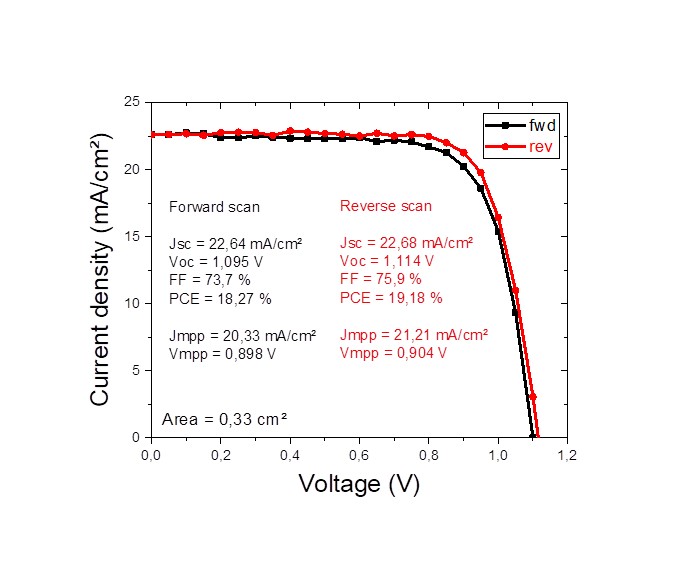Reflecting this particularly dynamic world race, power conversion efficiency (PCE) records, often obtained on very small surfaces, are currently rather frequent, and exceed 29% and 25% for tandem and single junction PK cells1, respectively.
Perovskites excite the community not only for their high performance, but also for the advantage to be produced using solution processed methods at low temperatures (below 150°C). These remain as key factors to further increase the attractiveness of this technology by meeting the criteria of industrialization and competitiveness. CEA at INES is conducting a work on the development of low temperature process for perovskite solar cell fabrication within the framework of the European APOLO project, whose objective is to develop single-junction flexible Perovskite photovoltaic modules.
Our laboratories had already obtained record performances with regard to the device surface2 (20.3% on 11.2 cm²) on rigid substrate (glass). They have just transferred this technology to a flexible substrate, by adapting the thickness of the active layer to the optical specificities of the substrate (PET/ITO) and the ratio of iodine to the bromine content to better tune the bandgap.
CEA has thus achieved average performances of about 18% for a batch of >30 single-junction flexible perovskite solar cells with a record cell at 19.18% with active surface area of 33 mm².

Current density-voltage characteristics of a record flexible cell
This result is to be compared with the best world performance on flexible substrate[1],[2],[3] (between 20 and 21% efficiency) which are achieved at temperatures up to 180°C, incompatible with the use of low cost substrates such as PET or on smaller active areas (of the order of 0.1 cm2). Benchmark performances are also more complex (anti reflection, mesoporous layers with more complex synthesis, and / or selective Spiro-Metad type holes). The technology developed by the CEA reconciles simplicity and performance.
The planar structure implemented by the CEA is rather simple and is based on double-cation (Cesium and Formamidinium) perovskite layer with promising stability results compared to technologies using a methylammonium cation, which is thermally poorly stable. Accelerated aging damp heat tests (at 85°C/85%RH) conducted at CEA on similar encapsulated flexible cells retained 90% of their initial efficiency even after 800h testing.
CEA at INES is working in parallel on the realization of larger flexible modules. These developments could lead to even higher performances due to a well suited electrical design with high geometrical fill factor. This was the case for the modules (11 cm²) fabricated on glass substrates. Researchers are also working on the development of industrially scalable deposition methods for different layers in the stack on high area substrates.
Acknowledgement for fundings from Institut Carnot Energies du Futur (Si-Premium and LASPV projects) and H2020 APOLO project (No 763989).
[1] https://www.nrel.gov/pv/assets/pdfs/best-research-cell-efficiencies.20200104.pdf
[1] https://www.chemistryworld.com/news/new-record-efficiency-for-flexible-perovskite-solar-cells/4012858.article#/
[2] Nano Energy 82 (2021) 105737, DOI: 10.1016/j.nanoen.2020.105737
[3] Energy Environ. Sci. 13, (2020), 13, 4854—4861, DOI: 10.1039/d0ee02164d
2 https://www.cea.fr/cea-tech/liten/english/pages/medias/news/pv-high-efficiency/new-record-for-perovskite-module-technology.aspx
3 https://www.chemistryworld.com/news/new-record-efficiency-for-flexible-perovskite-solar-cells/4012858.article#/
4 Nano Energy 82 (2021) 105737, DOI: 10.1016/j.nanoen.2020.105737
5 Energy Environ. Sci. 13, (2020), 13, 4854—4861, DOI: 10.1039/d0ee02164d